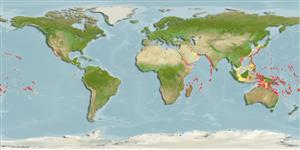Echinoidea |
Diadematoida |
Diadematidae
Environment: milieu / climate zone / تغييرات عمق / distribution range
بوم شناسي
وابسته به آب سنگ; تغييرات عمق 1 - 220 m (مرجع 95661). Tropical
Indo-Pacific: from Indian Ocean to Tahiti and from Japan to South Pacific Islands.
Length at first maturity / Size / Weight / سن
بلوغ: Lm ? range ? - ? cm Max length : 20.0 cm WD جنس نر / بدون خواص جنسي; (مرجع 87895)
Occurs in shallow coral and coral rubble areas at depths of 1 to 40 m (Ref. 81254), coral reefs and sandy areas (Ref. 129602). A generalist herbivore displaying nocturnal feeding behavior (Ref. 81254). Known to graze (Also Ref. 129602) on organic material and adults may also feed on live hard corals. Sometimes associated with commensal shrimp Stegopontonia commensalis (Ref. 800). Commonly found with Diadema spp. Bioeroder. Feeds on small and turf algae over hard substrates (Ref. 129602).
Life cycle and mating behavior
بلوغ | تولید مثل | تخم ریزی | Eggs | Fecundity | Larvae
Members of the class Echinoidea are gonochoric. Fertilization is external. Brooding is common, eggs are held either on the peristome, around the periproct or deep into the concavities on the petaloids. Life cycle: Embryos develop into planktotrophic larvae (echinoplateus) and live for several months before they sink to the bottom using their tube feet to adhere on the ground where they metamorphose into young urchins.
مآخذ اصلی
مراجع | هماهنگ كننده | همكاران
Schoppe, S. 2000 A guide to common shallow water sea stars, brittle stars, sea urchins, sea cucumbers and feather stars (echinoderms) of the Philippines. Times Media Private Limited, Singapore. 144 p. (مرجع 800)
وضعيت در فهرست قرمز IUCN
(مرجع 130435: Version 2025-1)
وضعيت از نظر سايتس (مرجع 108899)
Not Evaluated
Not Evaluated
خطر برای انسان ها
استفاده انسانی
ماهي گيري – شيلات: تجاري
| FishSource | Sea Around Us
ابزارها
اطلاعات بيشتر
Population dynamicsرشدMax. ages / sizesLength-weight rel.Length-length rel.نوسانات طولیMass conversionفراواني Life cycleتولید مثلبلوغFecundityتخم ریزیEggsنمو تخمLarvae PhysiologyOxygen consumption
Human RelatedStamps, coins, misc.
منابع اينترنتي
Estimates based on models
Preferred temperature
(Ref.
115969): 24.7 - 28.9, mean 27.5 (based on 362 cells).
Fishing Vulnerability
Low vulnerability (10 of 100).
طبقه قيمت
Unknown.
Nutrients : Calcium = 126 [75, 177] mg/100g; Iron = 5.08 [1.67, 7.92] mg/100g; Protein = 12%; Omega3 = 0.331 [0.263, 0.400] g/100g; Selenium = 0.04 [48.48, 67.17] μg/100g; VitaminA = 0 μg/100g; Zinc = 1.97 [0.92, 3.02] mg/100g (wet weight); based on
nutrient studies.
